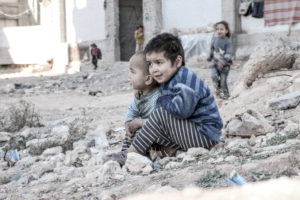
Trying to survive in poverty
As defined by economics, poverty is a state or condition in which a person or community lacks the financial resources and essentials to enjoy a minimum standard of life and well-being that is considered acceptable in society.
Did you know that 783 million people struggle to access clean water for daily living and nearly 2.5 billion people do not even have access to adequate sanitation? Due to the lack of infrastructure in most countries, 6 to 8 million people die each year from disasters and water-related diseases.
The problem does not end here. Poorer countries also lack modern energy services to fuel their houses. They lack access to electricity and clean cooking facilities that typically prevent air pollution from spreading in houses, leading to an increase in chronic diseases.
In over 38 countries in Africa, children live without electricity. Yet, without the continent’s natural resources, many nations would be facing an economic or social crisis.
The chart below representing the world’s top 20 poorest countries reveals some key evidence and pinpoints where we need to start in helping children.
The World's 20 Poorest Countries
| Poverty | Clean Water | Electricity | |
|---|---|---|---|
| 1. Syria | 82.5 | 90.0 | 95.8 |
| 2. Guinea-Bissau | 67.0 | 69.0 | 17.2 |
| 3. Burundi | 64.6 | 56.0 | 7.0 |
| 4. Guatemala | 59.3 | 93.0 | 85.49 |
| 5. Lesotho | 57.0 | 72.0 | 27.8 |
| 6. Togo | 55.1 | 63.0 | 45.7 |
| 7. Liberia | 54.1 | 70.0 | 9.1 |
| 8. Yemen | 54.0 | NA | 72.0 |
| 9. Cote d’Ivoire | 46.3 | 73.0 | 61.9 |
| 10. Mexico | 46.2 | 96.0 | 99.2 |
| 11. Niger | 45.4 | 46.0 | 14.3 |
| 12. Mozambique | 45.1 | 47.0 | 21.2 |
| 13. Timor-Leste | 41.8 | 72.0 | 45.4 |
| 14. Belize | 41.0 | 100.0 | 92.45 |
| 15. Seychelles | 39.3 | 96.0 | 99.5 |
| 16. Rwanda | 39.1 | 57.0 | 19.8 |
| 17. Greece | 36.0 | 100.0 | 100.0 |
| 18. El Salvador | 34.9 | 94.0 | 95.13 |
| 19. Gabon | 34.3 | 88.0 | 89.5 |
| 20. Argentina | 32.2 | 99.0 | 100.0 |
Resource: The World Factbook
The impact of poverty in Africa
The impact of poverty is most profound in Africa, where governments have been struggling to develop infrastructure due to poorly negotiated deals with other governments and international investors. (More information, about those Trade Agreement)
14 of the world’s top 20 poorest countries are from Africa, 2 from Central America, 1 from North America, 1 from the Caribbean, and 2 from the Middle East. As shown in the chart, populations in 13 countries do not have running electricity while 14 countries do not have access to clean water for their children.
Syria, the country with the highest poverty rate; is actively involved in a civil war. Which has caused massive human rights violations.
What does this tell us?
Poverty plays a major role in explaining why children are not attending school.
Without the government’s investment or support, billions of lives will not be able to reach their full potential. Instead, this will repeat a vicious cycle that will produce illiterate adults, increase unemployment rates, and contribute to the pattern of raising a generation of children living in poverty.